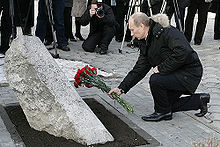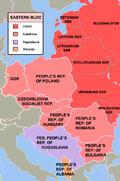- Novocherkassk massacre
-
The Novocherkassk massacre[1] or riots began on June 2, 1962 in the city Novocherkassk, Soviet Union (now Russia).
By early 1960s, a dire economic situation had developed in the USSR[2] By spring and the beginning of summer of 1962, the shortage of bread had become so evident, that Khruschev decided to start buying grain from abroad[3][4]
The riots were a direct result of shortages of food and provisions, as well as the poor working conditions in the factory. The protest began on June 1 in the Budyonny Electric Locomotive Factory, when workers from the foundry and forge shops stopped work after factory management refused to hear their complaints. The strike and attendant discussions had spread throughout the whole factory by noon.
The unrest began when Nikita Khrushchev doubled the prices of meat and butter on June 1, while increasing the minimum production quotas for each worker,[5] thereby effectively reducing pay rates.[6] This culminated in a march on the town hall and police headquarters, and the strike spread to other enterprises after police arrested thirty workers.
 Then President of Russia Vladimir Putin lays flowers at the memorial to the victims of the massacre on 1 February 2008.
Then President of Russia Vladimir Putin lays flowers at the memorial to the victims of the massacre on 1 February 2008.
Accounts of the government response are varied and often conflicting. There is some debate over who exactly fired on the demonstrators: the Soviet Army or the KGB. Some say that one army officer refused to order his men to fire on the protesters, and that KGB warning shots fired into the air hit children who had climbed into trees.[6]
According to now available official sources, 22 protesters were killed by the machine-gun-equipped[7] Soviet Army troops, and 87 were wounded. Three of the wounded later died. After the initial demonstrations, a curfew was implemented in the town. The dead bodies were secretly buried in the cemeteries of other towns of Rostov Oblast. However, the following morning, a large group of several hundred demonstrators again gathered in the square. One hundred and sixteen were arrested, of which fourteen were tried by show trials, and seven of those received a death sentence. The others were sentenced to prison terms of ten to fifteen years.[8]
Following the incident, the Soviet government directed extra food supplies to the region and began an investigation. Additional arrests of workers followed, as did courts martial of military officials involved. Aleksandr Solzhenitsyn claimed that individuals wounded in the unrest and their families were exiled to Siberia.
The whole story was never allowed to the press or any other Soviet mass media and remained classified until 1992, when the remains of 20 bodies were recovered and identified in 1992 on the cemetery of Novoshakhtinsk.
See also
- List of massacres in the Soviet Union
- Kengir uprising
- Vorkuta uprising
References
- ^ 1961: Novocherkassk Massacre
- ^ Что случилось в Новочеркасске? Генерал, который не стрелял
- ^ Почему Хрущев потерял власть
- ^ «ФАКТЫ и комментарии»
- ^ Vladislav Zubok and Constantine Pleshkov, Inside the Kermlin's Cold War: from Stalin to Khrushchev, Harvard University Press, p. 262
- ^ a b Hosking, Geoffrey. A History of the Soviet Union, Fontana Press, London. 1992.
- ^ And Then the Police Fired, TIME Magazine, October 19, 1962
- ^ Taubman, William. Khrushchev: The Man and His Era, First Edition, W. W. Norton & Co., New York, NY. 2003.
External links
Categories:- 1962 riots
- Massacres in the Soviet Union
- 1962 in the Soviet Union
- Riots and civil disorder in Soviet Union
- Food riots
- Protests in the Soviet Union
- Protest-related deaths
Wikimedia Foundation. 2010.

